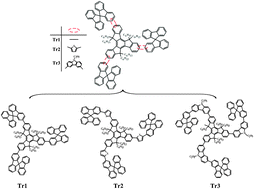The molecular picture of amplified spontaneous emission of star-shaped functionalized-truxene derivatives†
Abstract
Organic optical gain materials are the basis for organic solid-state lasers. However, the fundamental mechanism for Amplified Spontaneous Emission (ASE) is absent. Herein, three star-shaped molecules based on a truxene core with π-conjugated arms are studied to illuminate the influence of the molecular structure on ASE performance. We found that the three compounds demonstrated different ASE characteristics. The strong conjugated linkage in the molecular arms enhanced ASE, while the attenuated conjugated linkage deteriorates ASE for the given molecular structures. Based on the theoretical analysis, the conjugative coupling suppresses the low-frequency vibration, which is beneficial to the formation of an effective “four-level” energy system for ASE. On the contrary, the poor conjugative coupling brings out a mass of low-frequency modes, and hence, continuous vibronic energy sublevels will ruin the molecular “four-level” energy system. Our study presented a clear picture to clarify the ASE mechanism and offers valuable guidance for the design of new organic optical gain materials.


 Please wait while we load your content...
Please wait while we load your content...